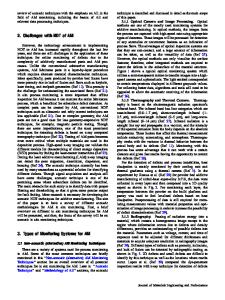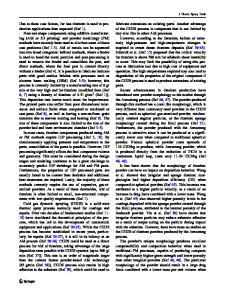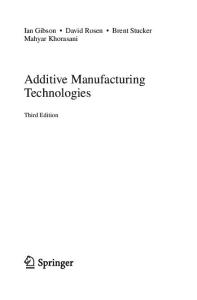Generalized Additive Manufacturing Process Chain
Every product development process involving an Additive Manufacturing machine requires the operator to go through a set sequence of tasks. Easy-to-use “desktop” or “3D printing” machines emphasize the simplicity of this task sequence. These desktop machin
- PDF / 214,991 Bytes
- 19 Pages / 439.37 x 666.142 pts Page_size
- 52 Downloads / 591 Views
Generalized Additive Manufacturing Process Chain
3.1
Introduction
Every product development process involving an Additive Manufacturing machine requires the operator to go through a set sequence of tasks. Easy-to-use “desktop” or “3D printing” machines emphasize the simplicity of this task sequence. These desktop machines are characterized by their low cost, simplicity of use, and ability to be placed in an office environment. For these machines each step is likely to have few options and require minimal effort. However, this also means that there are generally fewer choices, with perhaps a limited range of materials and other variables to experiment with. The larger and more versatile machines are more capable of being tuned to suit different user requirements and therefore are more difficult to operate, but with a wider variety of possible results and effects that may be put to good use by an experienced operator. Such machines also usually require more careful installation in workshop environments. This chapter will take the reader through the different stages of the process that were described in much less detail in Chap. 1. Where possible, the different steps in the process will be described with reference to different processes and machines. The objective is to allow the reader to understand how these machines may differ and also to see how each task works and how it may be exploited to the benefit of higher quality results. As mentioned before, we will refer to eight key steps in the process sequence: l l l l l l l l
Conceptualization and CAD Conversion to STL Transfer and manipulation of STL file on AM machine Machine setup Build Part removal and cleanup Post-processing of part Application
I. Gibson, D.W. Rosen, and B. Stucker, Additive Manufacturing Technologies, DOI 10.1007/978-1-4419-1120-9_3, # Springer ScienceþBusiness Media, LLC 2010
41
42
3 Generalized Additive Manufacturing Process Chain
There may be other ways to look at this process that depend on your perspective and equipment you are familiar with. For example, if you are a designer, you may see more stages in the product design. Model makers may see more steps in the post-processing of parts. However, our objective is to focus on the AM technology and so we will investigate the stages defined above in more detail. Different AM technologies need to be handled differently with regards to this process sequence, so this chapter will also discuss how choice of machine affects the generic process. We will also discuss how AM in general might affect the way models are designed. This is particularly relevant to applications where the intent is to avoid conventional manufacture, like machining and injection molding, in the production process. We are only just beginning to realize how designers can benefit from AM technology by being able to ignore some of the constraints of conventional manufacturing. However, conventional manufacturing cannot be ignored completely since it is still the core to how most products are manufactured. Thus, we must
Data Loading...











